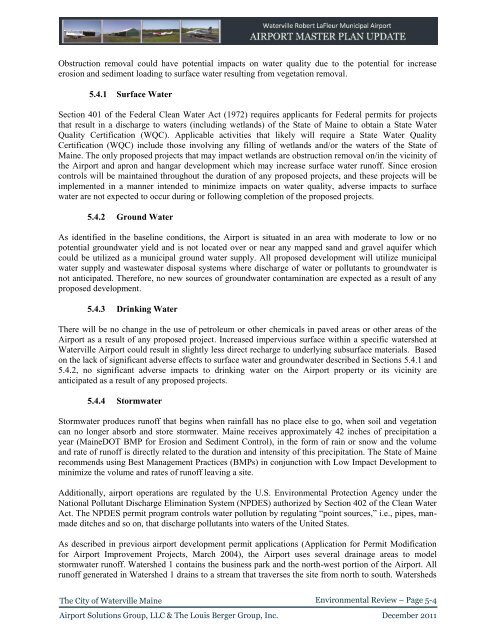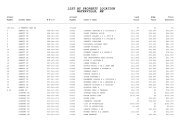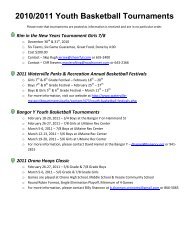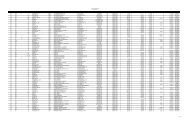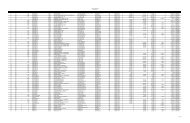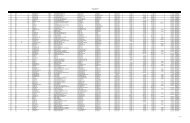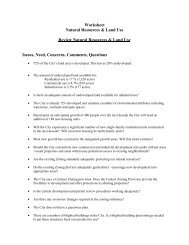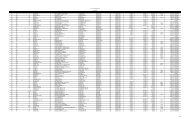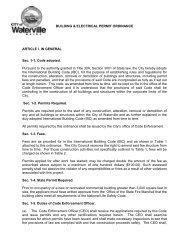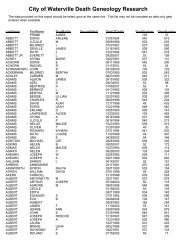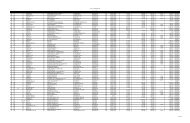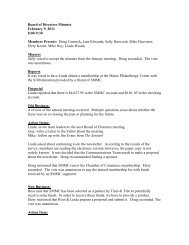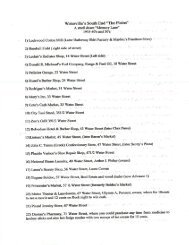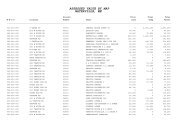Airport Master Plan 2012 - City of Waterville
Airport Master Plan 2012 - City of Waterville
Airport Master Plan 2012 - City of Waterville
You also want an ePaper? Increase the reach of your titles
YUMPU automatically turns print PDFs into web optimized ePapers that Google loves.
Obstruction removal could have potential impacts on water quality due to the potential for increase<br />
erosion and sediment loading to surface water resulting from vegetation removal.<br />
5.4.1 Surface Water<br />
Section 401 <strong>of</strong> the Federal Clean Water Act (1972) requires applicants for Federal permits for projects<br />
that result in a discharge to waters (including wetlands) <strong>of</strong> the State <strong>of</strong> Maine to obtain a State Water<br />
Quality Certification (WQC). Applicable activities that likely will require a State Water Quality<br />
Certification (WQC) include those involving any filling <strong>of</strong> wetlands and/or the waters <strong>of</strong> the State <strong>of</strong><br />
Maine. The only proposed projects that may impact wetlands are obstruction removal on/in the vicinity <strong>of</strong><br />
the <strong>Airport</strong> and apron and hangar development which may increase surface water run<strong>of</strong>f. Since erosion<br />
controls will be maintained throughout the duration <strong>of</strong> any proposed projects, and these projects will be<br />
implemented in a manner intended to minimize impacts on water quality, adverse impacts to surface<br />
water are not expected to occur during or following completion <strong>of</strong> the proposed projects.<br />
5.4.2 Ground Water<br />
As identified in the baseline conditions, the <strong>Airport</strong> is situated in an area with moderate to low or no<br />
potential groundwater yield and is not located over or near any mapped sand and gravel aquifer which<br />
could be utilized as a municipal ground water supply. All proposed development will utilize municipal<br />
water supply and wastewater disposal systems where discharge <strong>of</strong> water or pollutants to groundwater is<br />
not anticipated. Therefore, no new sources <strong>of</strong> groundwater contamination are expected as a result <strong>of</strong> any<br />
proposed development.<br />
5.4.3 Drinking Water<br />
There will be no change in the use <strong>of</strong> petroleum or other chemicals in paved areas or other areas <strong>of</strong> the<br />
<strong>Airport</strong> as a result <strong>of</strong> any proposed project. Increased impervious surface within a specific watershed at<br />
<strong>Waterville</strong> <strong>Airport</strong> could result in slightly less direct recharge to underlying subsurface materials. Based<br />
on the lack <strong>of</strong> significant adverse effects to surface water and groundwater described in Sections 5.4.1 and<br />
5.4.2, no significant adverse impacts to drinking water on the <strong>Airport</strong> property or its vicinity are<br />
anticipated as a result <strong>of</strong> any proposed projects.<br />
5.4.4 Stormwater<br />
Stormwater produces run<strong>of</strong>f that begins when rainfall has no place else to go, when soil and vegetation<br />
can no longer absorb and store stormwater. Maine receives approximately 42 inches <strong>of</strong> precipitation a<br />
year (MaineDOT BMP for Erosion and Sediment Control), in the form <strong>of</strong> rain or snow and the volume<br />
and rate <strong>of</strong> run<strong>of</strong>f is directly related to the duration and intensity <strong>of</strong> this precipitation. The State <strong>of</strong> Maine<br />
recommends using Best Management Practices (BMPs) in conjunction with Low Impact Development to<br />
minimize the volume and rates <strong>of</strong> run<strong>of</strong>f leaving a site.<br />
Additionally, airport operations are regulated by the U.S. Environmental Protection Agency under the<br />
National Pollutant Discharge Elimination System (NPDES) authorized by Section 402 <strong>of</strong> the Clean Water<br />
Act. The NPDES permit program controls water pollution by regulating “point sources,” i.e., pipes, manmade<br />
ditches and so on, that discharge pollutants into waters <strong>of</strong> the United States.<br />
As described in previous airport development permit applications (Application for Permit Modification<br />
for <strong>Airport</strong> Improvement Projects, March 2004), the <strong>Airport</strong> uses several drainage areas to model<br />
stormwater run<strong>of</strong>f. Watershed 1 contains the business park and the north-west portion <strong>of</strong> the <strong>Airport</strong>. All<br />
run<strong>of</strong>f generated in Watershed 1 drains to a stream that traverses the site from north to south. Watersheds<br />
The <strong>City</strong> <strong>of</strong> <strong>Waterville</strong> Maine<br />
Environmental Review – Page 5-4<br />
<strong>Airport</strong> Solutions Group, LLC & The Louis Berger Group, Inc. December 2011


